Site Links
Howdy, Stranger!
It looks like you're new here. If you want to get involved, click one of these buttons!
Quick Links
Categories
In this Discussion
Who's Online (0)
Scott's Amp Testing Thread
I had been looking at adding the capability to test amplifiers and receivers for some time. I learned about a company called Quantasylum from an Audio Science Review thread and subsequent review of their analyzer. For me their gear strikes a good balance between affordability, ease of use, and "good enough" capability for most of what I might want to do with it. Quantasylum is a very small business and supply chain challenges have been pretty severe for them, but in May 2023, I was able to acquire their QA403 audio analyzer and QA451 programmable load.

Since then, I have tested enough receivers and amps to have the process reasonably established, starting with some small cheap amps that had previously been tested elsewhere so I had a good idea that my results were reasonable. I will eventually post everything I have tested on my Google page (link from my signature). Here, I will post results that are of interest to MAC forum members for one reason or another, so I am looking for feedback and suggestions on that front.







Comments
I'd love to quantify the level of "meh" in the Dayton 4x100W DSP board. Should I send you one?
I had been looking at the Quantasylum gear a few years ago. It looks like great stuff that's fairly easy to use. No calibration would be heaven! I would have gladly bought their 402 analyzer, but getting one was almost impossible at the time.
That is an option. Before you do that, I recently tested an amp board sent to me by another forum member that uses the TDA7498E chip. The description of the Dayton board says TDA749x. The recommended power supply is approximately the same as what I tested. I have permission to post those results, so I will do that here. That should at least give some ideas what performance class we are looking at. There are expected to be some differences based on implementation, so it may still be worth testing the Dayton board.
Sehlin Sound Solutions
I tested the Sure/Wondom JAB5 which I believe is identical to the Dayton board. Here are some 4 Ohm load test results. I also did 8 Ohm load tests with nearly identical results. IMO Sure/Wondom comes up with interesting designs, but always fails in the execution. Over a decade ago Trevor Marshall showed how he reduced the distortion in a Sure 7498E amp by nearly 10 times by changing 1 cap per channel: https://trevormarshall.com/class-d-tutorial/.
Thanks, Ed. That probably tells me all I need to know. I was mostly interested to understand how much of a hit is caused by the ADAU1701 fronting the TDA.
From that graph, perhaps the DSP is the least of its issues.
I would conclude something similar, Dirk. Below I will post my results from testing a TDA7498E module purchased by a forum member from Amazon
https://www.amazon.com/ZK-1602-Amplifier-High-Power-TDA7498E-Bridging/dp/B0CFTK4D2Y/
I powered this with a 36V 320W meanwell power supply with +/- 15% voltage adjustment. 32V is the recommended voltage, so I did most of my tests there.
I start with a "dashboard" test at 1 kHz, 5W into a 4 ohm load to be comparable to the amplifier tests at Audio Science Review.
The THD+N is directly comparable to Ed's 5 watt (red curve at 1 kHz). The good channel on the Amazon amp was close to 0.05%, while the Sure/Wondom Amp looks like it was measuring closer to 0.045% - pretty close.
I measured distortion vs. power into 8 and 4 ohms.
For the Sure/Wondom amp, distortion at 1 kHz was up to almost 0.4% at 10W into 4 ohms, where the Amazon amp was still around 0.1%. By 25W, the Sure/Wondom is up over 1% THD+N while the Amazon amp does not cross that threshold until over 80 W. I was driving 2 channels for my tests, but am not sure how Ed's were run.
Frequency response for the Amazon amp was aggressively filtered - too much so for a 4 ohm load.
I would expect this to be a function of the implementation, not the TDA7498E itself, so this is likely different for the Sure/Wondom, or Dayton amp.
My other tests, power sweeps at different frequencies and a multitone test, look at amplifier performance vs. frequency.
As with Ed's testing one can clearly see diminished performance at higher frequency, which is at least somewhat of an issue with all class d amps I have tested or seen tested.
Sehlin Sound Solutions
Here is a picture of the device(s) under test.
Sehlin Sound Solutions
I was also curious if the amp could make it's claimed 160W x 2. I could only get about 130W by pushing the voltage to 36V. Better than I expected actually...
Sehlin Sound Solutions
That's a bit of a shame. Such a wonderful little piece of integration. Those boards do have a digital audio input and I was envisioning two of them fed by a raspberry pi providing the signal and the master clock. Already have a single board working off the Pi (using the generic I2S driver in Volumio).
So, it'll be ICE amps and some other analog devices DSP dev board. I'm not even super annoyed at the price delta. It's the extra components to be integrated--because now I'll need a module for balanced conversion, and so on. I don't know whether I have the head space.
ANYWAY...thank you @ScottS for sharing your scholarship. It's insightful.
Hey Dirk, I know you had asked about IcePower amps over on PETT. Somebody just posted some for sale on diyaudio.com, not sure if they are model you are interested in or not.
Dirk, looks like they have 10 of them for sale and may give a price break for multiples. How many do you want? I wouldn't mind having a few. Maybe we could work out a deal and take them off his hand a little cheaper.
Scott, check your PM sir.
I just bought an ADAU1452 dev board from flea-bay. Where did you see the ICE modules on diyaudio?
(maybe we should move over to the deals & steals thread to keep things clean for Scott)
Look at the swap meet area.
I posted the link over in the sales and deals thread. It's in the Swap Meet section as ugly_woofer suggested.
On the test "bench" today is the Dayton KAB-2150.
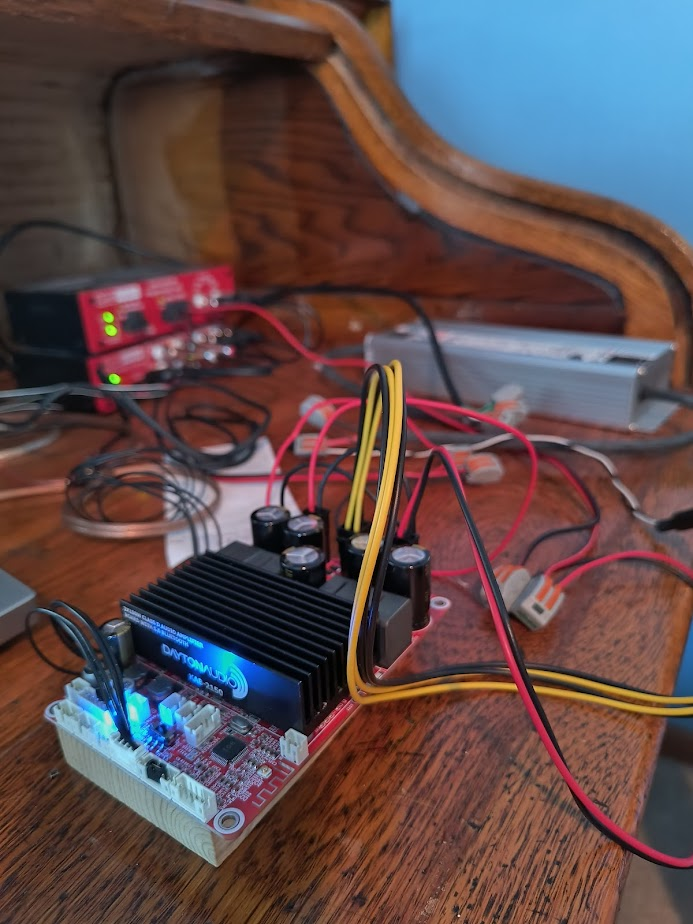
This amp board is regularly $47.98, but is currently on sale over at PE for $36.48. The one I have was a clearance center item priced at $28. The KAB-2150 uses the TI TPA3255 amplifier chip, which is used in some of the better regarded budget class d amps, such as the Aiyima A07, Topping PA5, and Fosi Audio (several models).
The KAB-2150 is a modular design with a lot of capabilities/options. The board includes bluetooth 5.0 along with the ability to add a couple of line inputs and a line output. A volume pot, tone controls, status LED's, and bluetooth antenna are also included in the box and can be plugged into the board as needed.
Here are the specs from the PE site:
• Working voltage: 18 to 36 VDC 8A Max
• Power output (w/ 36 VDC power supply): 2 x 150W @ 4 Ohm THD+N 10%
• Amp gain: 28 dB
• SNR: 90 dB 2 x 150W @ 4 Ohm, A-weighting
• Frequency response: 20 Hz to 20,000 kHz
• Crosstalk -68dB
• Switching frequency: SD floating @ 36V, 450 kHz
• Minimum load impedance: 3 Ohm
• Standby power: 0.1 mW when switched off on the board
• THD +N 5W @ 4 Ohm, 1 kHz: 0.01%
• Input Impedance: 20K Ohm
• Input sensitivity: 2 x 150W @ 4 Ohm, 1 kHz: 1V
• DC offset: 15 mV
• Board dimensions: 4.73" x 3.15" x 1.22" (120 x 80 x 31 mm)
• Mounting hole spacing: 4.42" x 2.84" (112 x 72.2 mm)
I tried a few things before deciding how to complete the testing.
• Some early TPA3255 amps came standard with a 32V power supply, so I tried that. The caps on board are rated at 63V, so I determined there was no downside to running at 36V (and there didn't appear to be any performance issues).
• According to the manual, bypassing bluetooth mode results in better audio performance, so I decided to test both ways.
• The manual indicates a 36V, 9A supply is needed to reach full output power, while the PE site recommends a 36V 5A supply. I tried both ways and will publish one graph showing the impact. The balance of testing reported here was completed with the 9A supply.
Let's start with the "dashboard" test - first in "bluetooth bypass" mode

In this mode, gain is slightly below spec, but close. Distortion was higher in 1 channel than the other. Distortion of 0.01% was met in the good channel. It might have been met in both channels if I had cut off distortion testing at 20 kHz - I extend to 45 kHz, which aligns with ASR tests and allows inclusion of 2nd and 3rd order distortion when testing up to 15 kHz. The good channel SINAD of 81.4 dB is close to the ASR result of 83 dB for the Aiyima A07.
For SNR my measurement is unweighted and at 5W rather than full power. I did note during power sweeps that the SNR was better than 90 dB at power levels approaching 150W, even before A-weighting.
Next is the same test with the board in bluetooth mode (analyzer is still going line in, but through the port that also allows bluetooth to function).

SINAD (equivalent to the opposite of THD+N) drops from 75-80 dB to 60. Gain is right at 28 dB. Clearly the issue is added noise as the SNR is almost the same as THD+N.
Next is frequency response.

In bluetooth bypass mode, response is typical for budget class d amps - a little damped into 4 ohms and slight ringing into 8 ohms. The spread at 20 kHz is only about 1.5 dB, so not bad. The only real issue is low frequency response, where we are about 4 dB down by 20 Hz. This is sort of like a built-in 30 Hz high pass, which would be welcome with many smaller ported speakers.
When bluetooth is activated, frequency response is impacted.

Response cuts off sharply above 22 kHz. Into 4 ohms, LF response is about the same as bluetooth bypass mode, but there appears to be additional filter interaction with the LF response into 8 ohms.
For power curves, I will first post what happened with a 36V 5A supply in bluetooth bypass mode.
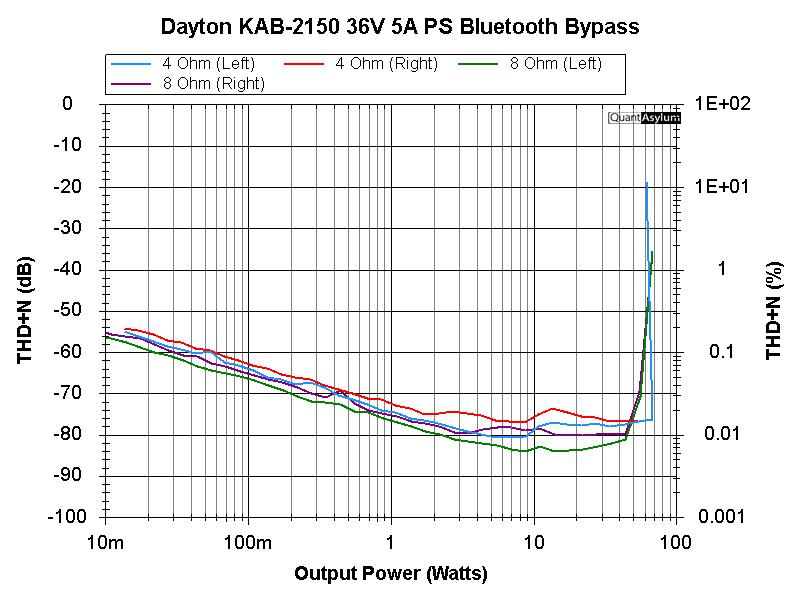
We get 45-50 watts per channel both channels driven at 1 kHz into 8 ohms. We run out of steam into 4 ohms around 70W. With the 9A supply, we get the power output at 4 ohms up to around 100W, where it should be.

The spec sheet claimed 2x150W into 4 ohms at 10% THD+N and eyeballing this graph, I would buy that. The last data point I took was at around 136W and less than 3% THD+N.
When bluetooth is activated, we see evidence of the higher noise floor in the THD+N vs. power curves. Overall power output is similar.

As with other TPA3255 amps, frequency dependence of THD+N is not as severe as most class D amps. Here is the family of curves in bluetooth bypass mode.
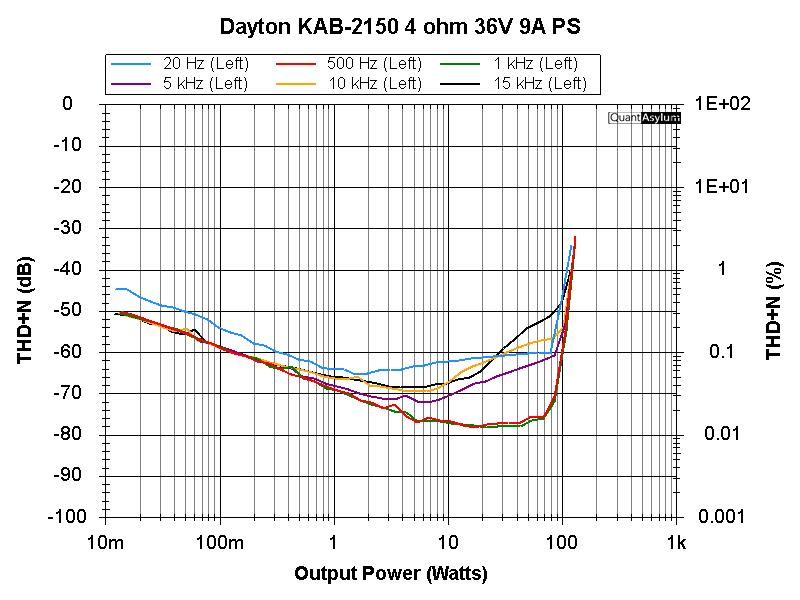
Best performance is at 500 Hz and 1 kHz. Distortion sets in early at 20 Hz, as well as at 5 kHz and above. Even with that, THD+N is below about 0.3% across the audio spectrum up to max power, which is pretty respectable especially considering price. Enabling bluetooth adds noise to everything.
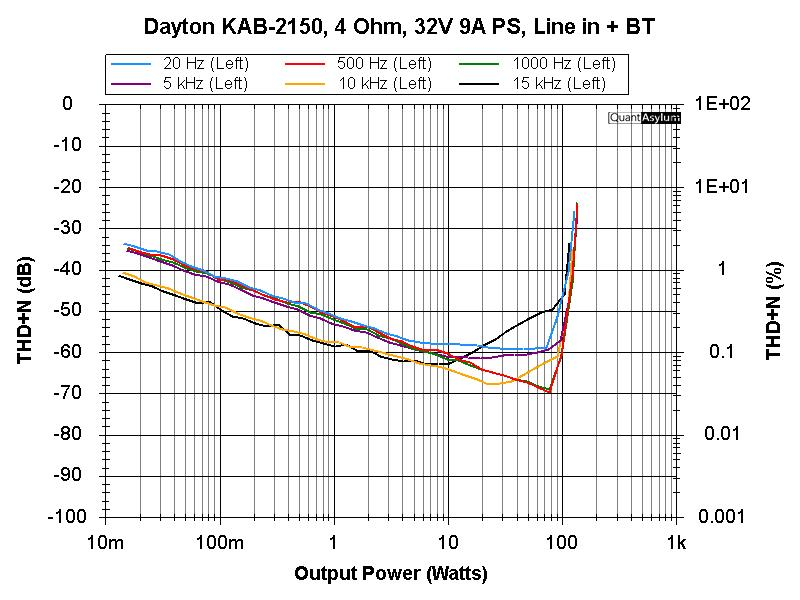
Oddly, there was less noise effect on the 10 and 15 kHz tones. Distortion didn't really seem to be impacted much by turning bluetooth on.
Multitone testing was about as expected.
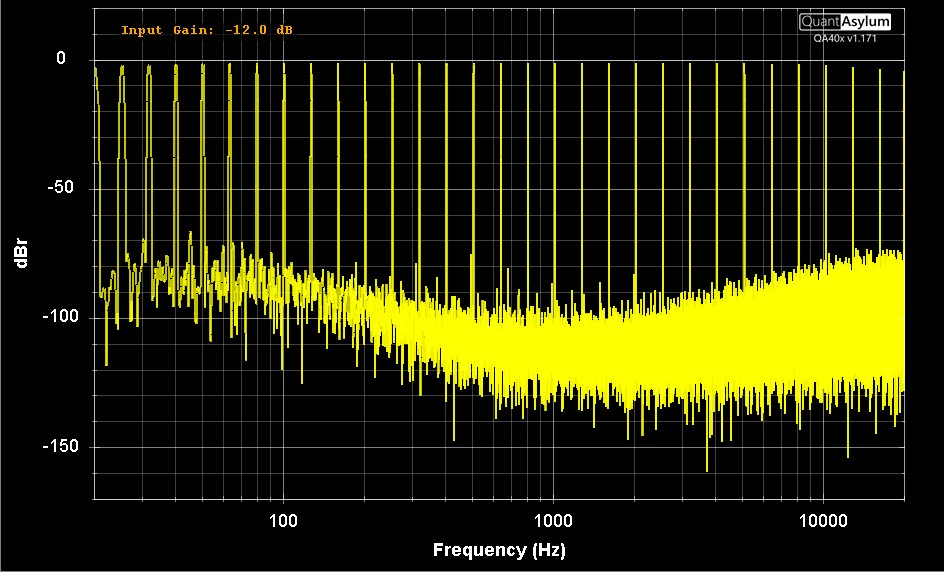
In bluetooth bypass mode, there is a full 16 bits of resolution (96 dB), but only from about 500 Hz to 2 kHz. At the frequency extremes, we have about 13 bits (78 dB).
Turning bluetooth on brings the noise floor up across the board, leaving about 12-13 bits (72-78 dB) of resolution across the frequency range.
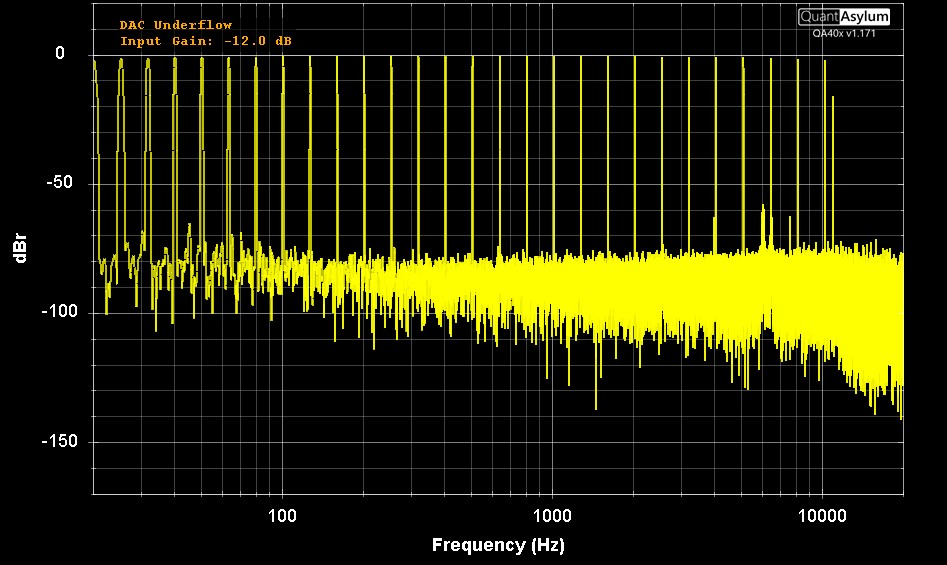
All in all, this board is pretty impressive for its price (especially the holiday sale price). Even with bluetooth enabled, it mostly outperforms the TDA7498E with similar output capability. As seen from other testing of TPA3255 amps at Audio Science Review and other places, there is more performance that could have been wrung out - but probably not for under $50 along with all the different settings and options. Subjectively, I replaced a pretty decent vintage receiver in the garage with an Aiyima A04 and don't really feel any loss in capability. I do feel the gain in bench space! I am thinking about replacing my marine receiver in my outdoor system with this next season (in an appropriate enclosure of course). I think the KAB-2150 has about 10x the power and less distortion/noise.
Sehlin Sound Solutions
Great work Scott.
ooh perty colors.
Fabulous technical report, Sir. Thanks.
Great info! I'm still a bit puzzled why these inexpensive amps & modules get away with using 10% THD for power specs. Yeah - it's about marketing to the masses. But once upon a time there were enforced (somewhat) standards for such things.
The smart shoppers look to tests like yours to find the truth.
Wow. Someone give this gentleman a gold star. Or a few. This is more useful than the 3 reviews that currently exist on the PE page.
Thank you, Scott, for taking the time to measure, document and publish this openly for our community.
Because the target audience looks at watts. I have seen some of the more scrupulous sellers list the wattage as lower. It's still basically the same charts, but if they market it as a 80W rather than 100W then they can claim the distortion specs constrained to an 80w max which is actually quite good.
Next up is the TinySine TSA8802B(Apt-X) amplifier board.
This board was generously donated by a forum member. It is a feature-rich product, including built-in Apt-X bluetooth and a ADAU1701 DSP chip on board. Here is a link to the product page.
https://tinysineaudio.com/products/2-x-100w-bluetooth-dsp-audio-amplifier-board-tsa8802bapt-x?_pos=8&_sid=dd8c20125&_ss=r
The specs for this amp are listed at 24V supply voltage, with an allowable range of 12V to 30V. Therefore, I will start with a set of measurements at 24V and "out of the box" condition. First, the dashboard at 5W output into 4 ohms.

SINAD is around 69 dB, SNR is around 80 dB and gain is just under 22 dB (a little below the spec of 24 dB) at these conditions. Recalling that the SINAD of the Dayton KAB-2150 was around 60 dB with bluetooth enabled, this is a nice improvement. The lower gain might be a factor in that. Next, let's look at the frequency response.
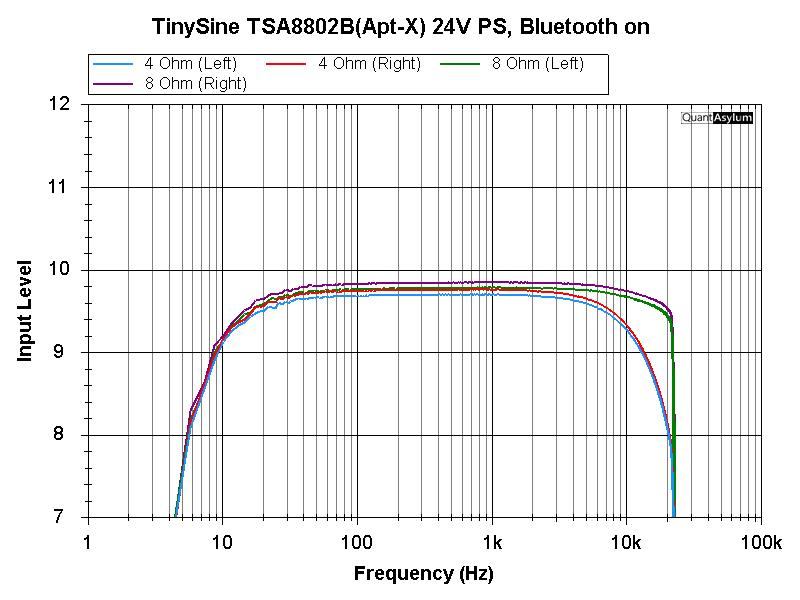
Low frequency response is strong - about 1 dB down at 10 Hz and maybe 0.1 dB down at 20 Hz. High frequency has the typical filtering plus a sharp cutoff at 22 kHz, like the KAB-2150. The TinySine board high frequency response is pretty well behaved overall - about 1.8 dB down at 20 kHz for a 4 ohm load and only about 0.3 dB down at 8 ohms.
Next, let's look at power output at 1 kHz. I ran the board with a 24V 13A (about 320W) Meanwell switching power supply to ensure that we wouldn't be current limited.

This amplifier was rated at 105W per channel at 10% THD+N into 4 ohms, but I was only able to manage about 75W. Overall, distortion starts to rise out of the noise floor above about 0.5W and sits at about 0.04% until about 4W into 8 ohms or 8W into 4 ohms, when it rises to about 0.1% until clipping starts (30W into 8 ohms and 60W into 4 ohms). Compared to the KAB-2150, this board shows far lower noise, but more distortion, particularly above 5W. There isn't much difference between left and right channel behavior, which is good and noteworthy. Next is the THD+N at other frequencies.

Distortion is pretty consistent up through 1 kHz, then is rising by 5 kHz. Audio Science Review tested the AIYIMA A05, which also uses the TPA 3221 amp chip and has bluetooth, back in 2021. The behavior measured here is similar except I think the TinySine board is better behaved, particularly at 20 Hz.
https://audiosciencereview.com/forum/index.php?threads/aiyima-a05-review-budget-amplifier.26440/
Last is the multitone test

We're seeing 12-13 bits of resolution, which is a lot like the KAB-2150 with bluetooth engaged and a bit better than the TDA7498E board previously tested. I think my next round of testing will look at pushing the voltage up a little to see how much more power output there is to be had. Then, I will take a look at some of the DSP/programming functionality. All-in-all, this board seems well-behaved for all of the features it has and the $60 price tag. I have been pleasantly surprised about the lack of glaring weaknesses. Typically in this size/price range there is at least one...
Sehlin Sound Solutions
Do any of these exhibit better behavior when fed battery DC vs switched vs traditional rectified?
Here's the THD+N vs. power at 27V supply voltage (voltage adjust knob on the 24V supply maxed out).
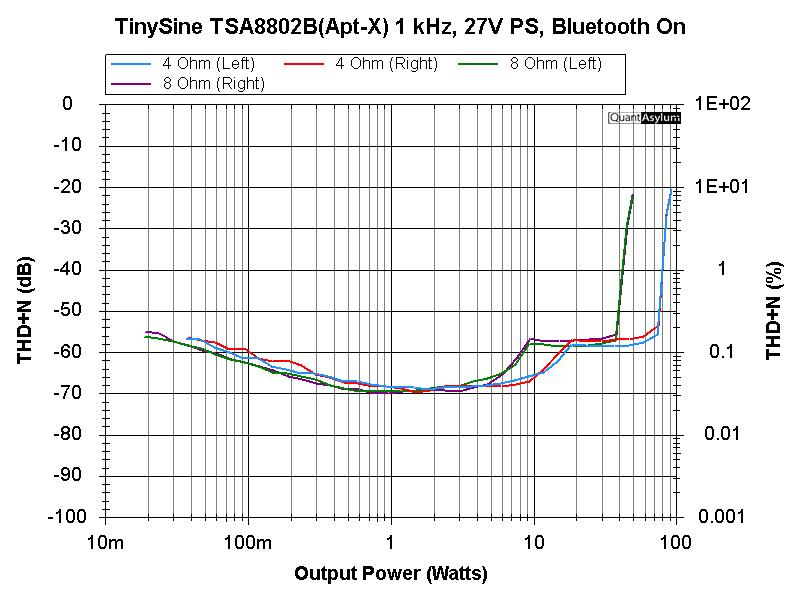
That gave a good boost from 30 to 38 watts per channel into 8 ohms and 60 to 75 watts per channel into 4 ohms. At 1% distortion, this is at about 41 WPC into 8 ohms and 80 WPC into 4 ohms. At 10% distortion, we are right around 50 WPC into 8 ohms and 90 WPC into 4 ohms. I don't have a good way to get high current at 30V at the moment (maybe Santa will have to do a little ebay shopping) but I would guess based on this that this will be fairly close to the spec sheet values driven at 30V.
Sehlin Sound Solutions
I think the noise floor from the bluetooth running on board would swamp most of those effects for the last couple of boards I have tested. It would be interesting to look at those effects, though. Right now, I have a pretty good sized lithium polymer battery in a boombox, but it's only a nominal 12V battery running a mobile audio head unit. The best performing mobile amp I have readily available for testing right now is a Lanzar Wrath, which despite intense skepticism on my part actually tested reasonably well with a big switching PS.
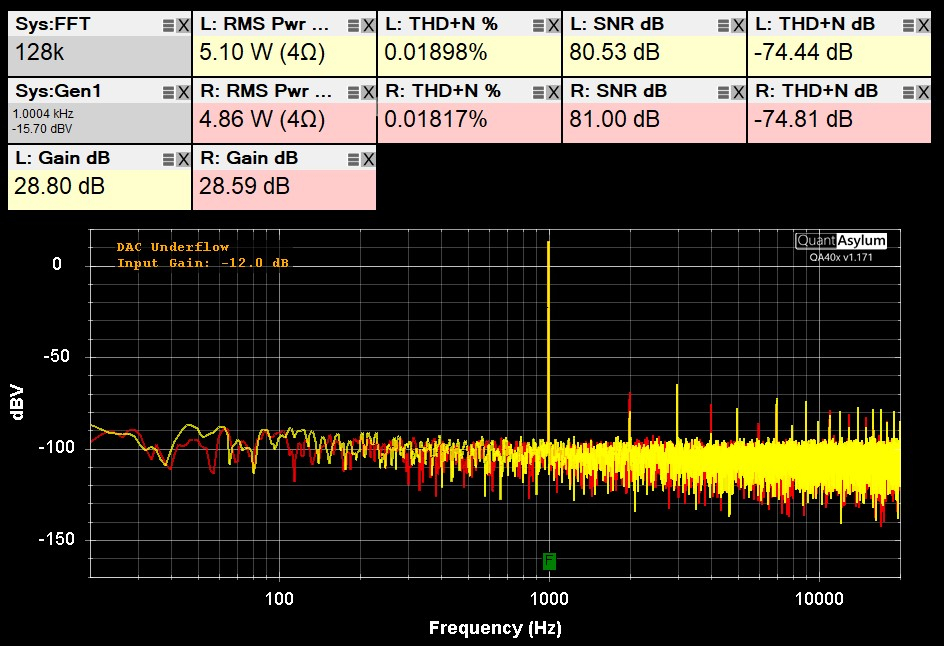
I'd be open to looking at a modular battery solution for variable voltage, but am not sure where to start. I'm sure there are battery pack DIY'ers who might have some ideas. A variable voltage transformer based PS is also an interesting idea, but I don't have a lot of experience with those, other than big old boat anchor power supplies I used to use in the lab 30-40 years ago. I don't see a lot of new ones around and older ones would probably need to be recapped at least.
Sehlin Sound Solutions
Thanks Scott. And thank you to the donor.
Perhaps I missed something; but is this the measurement through the line-input?
Or the Bluetooth input?
How does the unit receive Bluetooth audio? Is there a (de)attachable module Can it be exchanged for a digital input?
And btw, how noisy is the fan?
All in all looks like a nice deal for a functioning amp/DSP.
Thank you indeed to the donor
Measurement signal is through the single-ended line input. Below is a closer picture of the board. The bluetooth module is the small daughterboard on the right side of the board that includes the blue LED.
The fan never came on during testing. When I do my power tests, the FFT size is small and the sampling rate is 192k, so I stay at each power level for a fraction of a second. This keeps my electronic load from heating up too much and acts a lot like a music signal.
Sehlin Sound Solutions
Scott, I'll get that little amp out to you after Christmas is done and over with. I cannot believe how busy I have been the last two weeks at work.
Thanks for posting these reviews, they really tempt me to break down and buy the Quant Asylum gear! A problem testing amps with a DSP chip is that you’re also testing the DSP program provided by the vendor. A poorly designed program can adversely affect the SNR and SINAD, particularly when it comes to switching between analog and Bluetooth inputs. I’ve seen several different switching methods ranging from simple summation (the BT noise floor is always present) to rather complex signal detection and input switching. If you're wondering about the Bluetooth impact on TinySine products you can power down, remove the Bluetooth board and retest. Although I can understand why you may be hesitant when it’s not your board.
There’s definitely an error in the TinySine datasheet. They state the power supply voltage as 24V when listing their max power ratings. A quick look at the TPA3221 datasheet shows those power values are only possible with a 30V power supply. The datasheet matches your max power measurements when using a 24V supply.
I was also surprised to see the distortion rise in the 4W to clipping range. This must be a board implementation problem as the TPA3221 datasheet doesn’t show the rise.
PS – What is the “DAC Underflow” on the TSA8802B 1 KHz distortion graph?